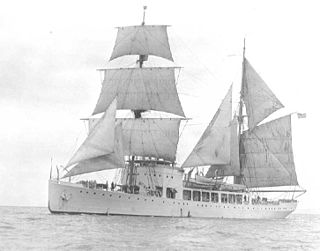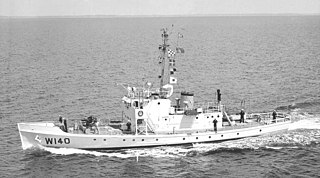History
Coast Guard service
The contract for her construction was awarded to the Bath Iron Works, Bath, Maine on 21 January 1931. She was commissioned as Coast Guard Patrol Boat No. 1 on 1 December 1931. [1] [3]
Assigned to the homeport of Stapleton, New York in 1931 she was transferred to Boston, Massachusetts in 1935. [1] On 1 July 1941, four months in advance of the directive whereby the United States Coast Guard was transferred from the United States Department of the Treasury to the United States Navy, Thetis and five of her sister ships were turned over to the Navy. This action occurred simultaneously with the establishment of the four Sea Frontiers. [3]
Four Thetis-class patrol boats, including Thetis, were assigned to the East Coast Sound School, Key West, Florida, for duty as patrol and training vessels. Their collateral duties included operating under the aegis of Commander, Task Force 6, on Gulf patrol duties. [1] [4]
World War II
At the time of the Japanese Attack on Pearl Harbor on 7 December 1941, Thetis was operating out of Key West. In or around February 1942, Thetis was classified as a patrol craft and given the hull classification symbol WPC-115. [3]
Thetis's antisubmarine warfare (ASW) training missions were conducted along with local patrol and escort duties out of Key West from 1941 to June 1945. On 13 June 1942, Thetis located U-157 and sunk her in a single depth charge attack. On 7 January 1944 she rescued seven survivors from USS St. Augustine which had accidentally been rammed by merchant tanker Camas Meadows off the coast of Cape May, New Jersey. [4] [5]
Post war service
In June 1945, Thetis was assigned to air-sea rescue service with the Third Coast Guard District. [4] She was decommissioned on 1 July 1947 and sold on 1 July 1948. [4]

USCGC Triton (WPC-116), a steel-hulled, diesel-powered Thetis-class patrol boat of the United States Coast Guard, was the fourth commissioned ship of the United States to be named for Triton, a Greek demigod of the sea who was the son of Poseidon and Amphitrite. She served almost simultaneously with the submarine of the same name. Today, she serves as a tour boat in New York City for Circle Line Sightseeing Cruises, and carries the name Circle Line XVII.
Five ships of the United States Navy have borne the name Alert. During World War I, three ships held the name simultaneously.

USCGC Icarus (WPC-110) was a steel-hulled, diesel-powered Thetis-class patrol boat of the United States Coast Guard that patrolled the United States East Coast during World War II. In 1942, Icarus sank the German submarine U-352 off the coast of North Carolina and took its survivors into custody as prisoners of war. U-352 was the second World War II U-boat sunk by the United States in American waters, and the first one from which survivors were taken.

USCGC Tallapoosa (WPG-52) was a United States Coast Guard cutter of the Tallapoosa-class and was designed to replace the revenue cutter Winona. Her hull was reinforced for light icebreaking. She was initially stationed at Mobile, Alabama, with cruising grounds to Lake Pontchartrain, Louisiana and Fowey Rocks, Florida. During World War I she escorted convoys out of Halifax, Nova Scotia. After the war she served with the Bering Sea Patrol before returning to Savannah, Georgia before World War II. During the war Tallapoosa assisted with convoy escort duty and anti-submarine patrols.

USCGC Cape Henlopen was a 95-foot (29 m) type "C" Cape-class cutter constructed at the Coast Guard Yard at Curtis Bay, Maryland in 1958 for use as a law enforcement and search and rescue patrol boat.

USCGC Northland (WPG-49) was a United States Coast Guard cruising class of gunboat especially designed for Arctic operations that served in World War II and later served in the Israeli Navy. She was the last cruising cutter built for the Coast Guard equipped with a sailing rig.

The third USS Calypso (AG-35) was launched 6 January 1932 for the United States Coast Guard as USCGC Calypso (WPC-104) by the Bath Iron Works in Bath, Maine. She was initially stationed at San Diego, California and transferred to Baltimore, Maryland in 1938. She was transferred from the Coast Guard to the U.S. Navy on 17 May 1941 and commissioned the same day.

The Active-class patrol boat was one of the most useful and long-lasting classes of United States Coast Guard cutters. Of the 35 built in the 1920s, 16 were still in service during the 1960s. The last to be decommissioned from active service was the Morris in 1970; the last in actual service was the Cuyahoga, which sank after an accidental collision in 1978.

USCGC General Greene (WPC/WSC/WMEC-140), was a 125 ft (38 m) United States Coast Guard Active-class patrol boat, in commission from 1927 to 1968 and the fourth cutter to bear the name of the famous Revolutionary War general, Nathanael Greene. She served during the Rum Patrol, World War II and into the 1960s performing defense, law enforcement, ice patrol, and search and rescue missions.

USCGC Marion (WSC-145), was a 125 ft (38 m) United States Coast Guard Active-class patrol boat in commission from 1927 to 1962. She was named for Francis Marion, an American Revolutionary War general who was known for his unconventional warfare tactics. Marion served during the Rum Patrol and World War II performing defense, law enforcement, ice patrol, and search and rescue missions. Most notably, Marion served as the platform for the first intensive oceanographic studies made by the Coast Guard.

USCGC Crawford (WSC-134), was a 125 ft (38 m) United States Coast Guard Active-class patrol boat in commission from 1927 to 1947. She was named for William H. Crawford, (1772–1834) who was appointed in 1816 as Secretary of the Treasury by President James Madison and he continued under President James Monroe through 1825. Crawford was the seventh vessel commissioned by the U.S. Revenue Cutter Service and the Coast Guard named after the former secretary. She served during the Rum Patrol and World War II performing defense, law enforcement, ice patrol, and search and rescue missions.

USCGC Unalga (WPG-53) was a Miami-class cutter that served in the United States Revenue Cutter Service and later the U.S. Coast Guard and U.S. Navy. The early part of her career was spent patrolling the Pacific coast of the United States and the Bering Sea. After 1931 she did patrol work off Florida and in the Caribbean. After Unalga was sold in 1946, she was renamed after Jewish Agency leader Haim Arlosoroff and used for six months for moving Jewish refugees from Europe to Palestine before being forced to run aground by British Navy ships near Haifa.
USCGC Cape Cross was a 95-foot (29 m) type "C" Cape-class cutter constructed at the Coast Guard Yard at Curtis Bay, Maryland in 1958 for use as a law enforcement and search and rescue patrol boat.
USCGC Cape Horn was a 95-foot (29 m) type "C" Cape-class cutter constructed at the Coast Guard Yard at Curtis Bay, Maryland in 1958 for use as a law enforcement and search and rescue patrol boat.
USCGC Cape Darby was a 95-foot (29 m) type "C" Cape-class cutter constructed at the Coast Guard Yard at Curtis Bay, Maryland in 1958 for use as a law enforcement and search and rescue patrol boat.
USCGC Cape Shoalwater was a 95-foot (29 m) type "C" Cape-class cutter constructed at the Coast Guard Yard at Curtis Bay, Maryland in 1958 for use as a law enforcement and search and rescue patrol boat.

USCGC Argo (WPC-100) was a Thetis-class patrol boat belonging to the United States Coast Guard launched on 12 November 1932 and commissioned on 6 January 1933.
USCGC Atalanta (WPC-102) was a 165-foot (50 m), steel-hulled, diesel-powered Thetis-class patrol boat of the United States Coast Guard.
USCGC Aurora (WPC-103) was a 165-foot (50 m), steel-hulled, diesel-powered Thetis-class patrol boat of the United States Coast Guard.

USCGC Morris (WSC-147), was a 125 ft (38 m) United States Coast Guard Active-class patrol boat in commission from 1927 to 1971. She was named for Robert Morris, (1734–1806) who was appointed in 1789 as United States Senator from Pennsylvania. In May 1966, she was redesignated as (WMEC-147).









